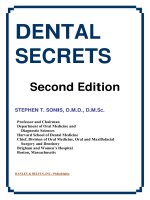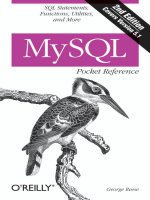Environmental Communication Second Edition doc
Bạn đang xem bản rút gọn của tài liệu. Xem và tải ngay bản đầy đủ của tài liệu tại đây (3.72 MB, 315 trang )
Environmental Communication
Second Edition
Richard R. Jurin
●
Donny Roush
Jeff Danter
Environmental
Communication
Skills and Principles for Natural Resource
Managers, Scientists, and Engineers
Second Edition
Richard R. Jurin
School of Biological Sciences
University of Northern Colorado
Greeley, CO
USA
Jeff Danter
The Nature Conservancy
Florida Chapter
USA
Donny Roush
Odyssey School
Denver, CO
USA
ISBN 978-90-481-3986-6 e-ISBN 978-90-481-3987-3
DOI 10.1007/978-90-481-3987-3
Springer Dordrecht Heidelberg London New York
Library of Congress Control Number: 2010924748
© Springer Science+Business Media B.V. 2010
No part of this work may be reproduced, stored in a retrieval system, or transmitted in any form or by any
means, electronic, mechanical, photocopying, microfilming, recording or otherwise, without written
permission from the Publisher, with the exception of any material supplied specifically for the purpose
of being entered and executed on a computer system, for exclusive use by the purchaser of the work.
Cover illustration: ‘Rock Wall in Forest’ by Ken Shearer
Printed on acid-free paper
Springer is part of Springer Science+Business Media (www.springer.com)
v
Preface
A
rock wall stands on a forest floor in New England. This wall was built
when the United States was a young nation, by human hands. Between its
origin (circa 1800) and now, there have been shifts in this scene – some
marked, some less apparent.
On both sides of the wall, a second-growth forest stands, having replaced
virgin woods, removed in all likelihood well before the fence was put in place.
On the boulders comprising the fence, lichen colonies have formed, a phenomenon
requiring decades without disturbance. This structure likely used to mark the
edge of a farm field, from which food and fiber were extracted. The practical
purposes of the wall were to mark a boundary and to provide a place for disposal
of rocks, to lessen the difficulty of plowing. Such rock fences are the residue of
difficult, extensive work.
The wall’s communicative purpose was to proclaim dominion. Pioneers who
built rock fences meant to let others know that this was their land, that a family
made its living here. Theirs was a thoroughly un-modern and close relationship
with the land. The wall is a message, encoding a bit of human–land interaction in
the United States. It is an American environmental communication.
Photographer Ken Shearer captured this wall one autumn while touring the
backwoods of Vermont and Maine. He recalls miles and miles of these rock walls
standing along country lanes. Shearer uses large format cameras, to produce pho-
tographs of tremendous beauty and power. We liked his photograph very much and
hope you do too.
This book is about communication and our environment. We mean for our cover
to be indicative of what is inside.
We hope to convey additional messages through the graphic design of the cover
and this page. First, the earthy tones in the cover photograph are meant to remind
viewers of the natural world. The greens, yellows, browns and grays within the
image denote autumn in a temperate, deciduous forest, an ecosystem familiar – at
least vaguely – to most. One shade of gray is picked up and repeated as the drop
capital for this preface. Here our meaning was subtler. Environmental communica-
tion deals in many, many gray areas. Uncertainty is rife in environmental science;
rarely do we have clear answers about the environmental effects of post-industrial
human society. Most always, clear answers take much longer to uncover than we
vi Preface
wish. Message-makers have to consider what is known and present remedies based
on the preponderance of the evidence, evidence usually still clouded by at least
shadows of reasonable doubts. This task is not easy.
But, it is a necessity if we – as individuals, as groups, and as a society – are to
continue to redirect ourselves toward sustainability. We are not alone in this type of
thinking about environmental communication. Indeed, voices of leading scientists,
communicators, and activists have grown more voluminous and more harmonious,
breaking into a distinct chorus in the 1960s. Since the turn of the millennium, there’s
been a notable amplification as environmental messages have accelerated, become
heightened, and have penetrated further into our collective psyche. Behaviors are
shifting as a result. Green is in.
To keep society moving toward sustainability, environmental communicators
have to work skillfully with more than mere information. ‘Conservationists, who
after all are inspired to work in conservation not just because of information they
have but because of how it makes them feel, need to find better ways to fuse scien-
tific information with a wider array of human values,’ writes Safina (2008) in
A Passion for This Earth: Writers, Scientists, and Activists Explore Our Relationship
with Nature and the Environment. ‘Think of it as a question of translation.
‘This is not a matter of manipulating people; it’s a matter of communicating
matters of the utmost importance to the future of life. Science needs a human face.
We need to increasingly focus on formulating messages that allow people to recog-
nize themselves.
‘Because we are talking about health and the ability of our planet to continue
supporting life, formulating such messages should be possible. There has never
been a more important time to take a new approach to communicating.’ [Emphasis
in original.]
We wholeheartedly agree. Indeed, such environmental communications –
defensible in their factual claims, voiced clearly by reputable professionals, and
prescriptive at their conclusions – are imperative and need to be applied by all
professionals involved in the management of the Earth’s natural resources.
Scientists, engineers, and natural resource managers must repeatedly bring
knowledge and solvent ideas to bear on our environmental problems, as part of
larger public discourses. Their messages need to be salient and sensible, as the
wider populace will not necessarily accept as stone-carved fact, or even respect,
the contentions of trained environmental professionals based solely on reputable
standing. In our twenty-first century world, mediated messages exist in a clut-
tered marketplace of ideas; much is plain noise and distracting. Serious dialogue
about our environment must cut through this clamor. In this book, we hope to
provide pointers to assist in the construction of well-planned, well-targeted, and
efficacious environmental communications.
So, this work is meant as a compendium for anyone who communicates about
nature, natural resources, ecology, and environmental processes. Whether you work
for a non-profit organization, as part of a for-profit business, within a government
agency charged with management and policy-making, or as a free-agent activist, we
viiPreface
aim to provide a handy reference filled with focused suggestions and know-how. The
high stakes of environmental situations demand more from one’s communications.
In your use of this book, realize that even as we discuss communications in
discrete ‘chunks,’ we attempt to point out threads of integration among topics.
We always seek to retain a holistic perspective on environmental issues. In the
glorious words of John Muir: ‘When we try to pick out anything by itself, we find
it hitched to everything else in the universe.’
Holism is a strategy toward the goal of sustainability – human habitation of our
planet without compromising environmental quality, without destroying the other
components of the biosphere. If the goal is sustainability, then everything must be
geared toward that goal. Our fervent hope for our book is that it will supplement
your knowledge and skills as a tool helpful for your own journeying as an environ-
mental communicator. Whether you are an environmentalist, an industrialist, part
of a community group, or an individual trying to make a difference, we hope this
book offers a way to meet your objectives.
Keep up the good work.
How We Organized This Book
More than anything, we have tried to do the winnowing for you, removing the less-
than-essential to leave only the most valuable nuggets. We want our work to be
readable and manageable in size, while offering high-value content. If you desire
more information, we have included a ‘Further reading’ within the reference list at
the end of each chapter.
The book is organized into three main sections. Part I sets the stage, giving a brief
conceptual framework for the field of environmental communications. Part II delves
into the basics of communication planning. Planning is to communicating what car-
tography is to travel. If you have a suitable and accurate map, getting there – wherever
‘there’ may be – is much, much more likely to happen. We want you to arrive where
you expect. Randomly setting out on a journey without a clear direction can be excit-
ing, but can take you to destinations you would be better to avoid.
Part III can be thought of as our toolbox, from which you may select any of
many communication competencies. Chapters 10–15 cover skills and applications
you need when working directly with people. Successfully interacting with people
requires a whole box of tools, which come more naturally to some and not others.
These tools range from speaking dynamically to an audience, to understanding why
people think and act the way that they do. At Chapter 16, we broaden from inter-
personal communicating to mass mediation of messages. The most prolific source
of environmental information today is the news media, including those on the
Internet. With help, this pervasive system can be navigated, to ensure messages are
reported as intended. Chapters 17 and 18 review conflict management and risk.
Conflict is a given in life, especially with human–environment interactions. Finally,
Chapters 19 and 20 cap our discussions with an overview of communications as
viii Preface
means of changing harmful behaviors and as a way of solidifying societies’ reori-
entation to sustainability, our ultimate goal.
Reference
Safina C (2008) Let every tongue speak and each heart feel. In: Benjamin M (ed.) A passion
for this Earth: writers, scientists, and activists explore our relationship with nature and the
environment. Greystone and David Suzuki Foundation, Vancouver.
ix
Acknowledgments
The impetus for writing this book was twofold. First, at a conference of environ-
mental communicators in Chattanooga in 1995, a discussion arose about the need
for a comprehensive and up-to-date introductory communications text for univer-
sity undergraduate students and professionals in the field. Second, at The Ohio
State University, a communications course is required for all students seeking a
bachelor’s degree from the School of Natural Resources. The packet of materials
for that course evolved over many years, and transferred this myriad of handouts,
readings, ideas, and exercises, plus a myriad collection of other ideas into a unified
text that became the first edition, and now the second edition.
Although each chapter was written by the authors, it was in some way based on not
just our ideas but on many other colleagues’ ideas developed over several years.
Their comments and feedback were truly invaluable. We specifically thank Dr. John
Disinger, Dr. Rosanne W. Fortner, Dr. Joseph E. Heimlich, Dr. Gary W. Mullins,
Dr. Robert E. Roth, and Dr. Stefan Somer for ideas and comments with preliminary
versions of the chapters in the first edition. Dr. Nicholas J. Smith-Sebasto is gratefully
acknowledged for his help with the first edition on the preliminary draft of the outline.
Although this second edition is our own expanded tome, thanks for helping
hands and thoughts go out to Bridget Arend, Holly Hitzemann, Ken Shearer,
Pamela Hill, Vivian Puxian, Jeff Brenman, Pawan Jaswal and Tammy Herring.
Gratitude also goes to the unsung heroes working as research librarians at Denver
Public Library, Harvard University’s Museum of Comparative Zoology, The Ohio
State University and Washington University Law Library.
We thank close friends and family members for their incredible patience and
support.
Finally, to our editors over the long haul of this second edition, Judith Terpos
and Tamara Welschot, our grateful thanks for their support, and patience.
The authors acknowledge that there are instances where they were unable to
trace or contact the copyright holder for permission to reproduce selected material
in this volume. The authors have included complete source references for all such
material and takes full responsibility for these matters. If notified, the publisher will
be pleased to rectify any errors or omissions at the earliest opportunity.
Richard R. Jurin, Donny Roush and Jeff Danter
xi
Contents
Part I Principles of Environmental Communication
1 Understanding the World Around Us 3
1.1 Introduction 3
1.2 Axioms for Environmental Communications 3
1.3 A Brief History of Environmental Communication 5
1.3.1 Nature Writing 7
1.3.2 Outdoor Recreation and Travel Writing 7
1.3.3 Science Writing 7
1.3.4 Public Affairs Reporting 8
1.3.5 Persuasion 8
1.4 The Growth of Environmental Communication 9
1.4.1 1969–1974 12
1.4.2 1989–1994 13
1.4.3 2002 Onward 13
1.5 Definitions of ‘Environmental Communication’ 13
1.6 Models of Environmental Communication 15
1.6.1 Communicating Environmental Information Model 15
1.6.2 Ecological Model of the Communication Process 18
1.7 A Sense of Place 19
1.8 What Is Sustainability? 20
1.9 Education for Sustainable Development 22
1.9.1 Case Studies: Education for Sustainable
Development (ESD) 23
References and Further Reading 24
2 Communicating About the Environment 27
2.1 Introduction 27
2.2 Communication Modeling and Theory 28
2.2.1 Communication Perspectives 30
2.2.2 Message Elaboration 30
2.3 What Are the Differences and Similarities Among Environmental
Communication, Environmental Education and Environmental
Interpretation? 31
xii Contents
2.4 Principles of Adult/Community Education 33
2.5 Implications for the Professional 34
2.5.1 Case Study: Environmental Education Project WILD 35
2.5.2 Case Study: Environmental Interpretation. Great Barrier
Reef Marine Park 36
2.5.3 Case Study: Environmental Communication 37
References and Further Reading 37
3 Developing Your Environmental Literacy 41
3.1 Introduction 41
3.2 Literacy 42
3.3 Numeracy 42
3.4 Science Literacy 43
3.5 Environmental Literacy 45
3.5.1 Degrees of Environmental Literacy 45
3.5.2 Measuring Environmental Literacy 46
3.6 Ecological Literacy 48
3.6.1 Nature-Deficit Disorder 49
3.6.2 No Child Left Inside 49
3.7 How Science Information Becomes Reliable 50
3.7.1 Frontier Science 52
3.7.2 Primary Literature 52
3.7.3 Secondary Literature 52
3.7.4 Textbook Science 53
3.7.5 The Internet and the Knowledge Filter 53
3.8 Thinking Critically About Scientific Information 54
3.8.1 Does Their Argument Make Sense? 54
3.8.2 Who Is the Source of the Information? 55
3.8.3 Are the ‘Facts’ Placed in a Context
of Accepted Knowledge? 55
3.8.4 How Was the Information Obtained? 55
3.8.5 What Kind of Study Was Reported? 56
3.8.6 Were Measurements and Statistics Used Properly? 56
3.9 The Art of Argumentation 57
3.10 Case Study: Environmental Literacy.
Last Child in the Woods 60
References and Further Reading 61
4 Investigating Environmental Issues 63
4.1 Introduction 63
4.2 Components of Issue Analysis 64
4.3 How Issues Arise 65
4.4 Dissecting Issues 66
4.5 Value Descriptors 68
4.6 Global vs. Regional vs. Local Issues 69
4.7 Framing and Framing Anew 70
xiiiContents
4.8 Case Study: Environmental Issue Analysis.
Ohio Beverage Container Deposit Legislation 71
References and Further Reading 72
Part II Communication Planning
5 Planning Environmental Communications 75
5.1 Introduction 75
5.2 A Process for Planning Campaigns 75
5.2.1 Problem Statement 76
5.2.2 Goals 77
5.2.3 Audience Analysis 77
5.2.4 Objectives 77
5.2.5 Message Development/Media
Options/Audience Suitability 78
5.2.6 Media Choice and Design 79
5.2.7 Timeline 79
5.2.8 Front-End Evaluation 79
5.2.9 Formative Evaluation 79
5.2.10 Summative Evaluation 80
5.2.11 Project Budget 80
5.3 An Outline for Writing a Communication Plan 80
5.4 Case Study: Environmental Communication Planning 81
References and Further Reading 82
6 Analyzing Your Audience 83
6.1 Introduction 83
6.2 Internals Versus Externals 84
6.3 Population Segmentation 85
6.3.1 Adoptions of New Ideas 85
6.3.2 Support of Pro-environmental Issues 86
6.3.3 Fragmentation, Selectivity and Loyalty 87
6.4 Adopting New Ideas 88
6.4.1 Awareness 89
6.4.2 Interest 89
6.4.3 Evaluation 89
6.4.4 Trial 90
6.4.5 Adoption 90
6.5 Beliefs, Values, Attitudes, Worldviews, and Opinions 90
6.5.1 Belief 91
6.5.2 Value 92
6.5.3 Attitude 93
6.5.4 Worldview 93
6.5.5 Opinion 93
6.5.6 Situational Factors 93
6.6 Memes 94
xiv Contents
6.7 Locus of Control 95
6.8 A Model of Citizen Participation 97
6.8.1 Entry Level Variables + Ownership Variables +
Empowerment Variables → Environmentally
Responsible Behavior 97
6.9 Motivation 98
6.9.1 Motivational Needs Models 99
6.9.2 How to Motivate Adults 100
6.10 Consumerism as a Way to Understand Preferences 101
6.10.1 Business Communication to Assist Consumer Choice 102
6.11 Case Study: Audience Analysis. Environmental Radio
Soap Opera for Rural Vietnam 103
References and Further Reading 103
7 Evaluating Your Messages’ Effects 107
7.1 Introduction 107
7.2 Purposes of Evaluation 107
7.3 Methods of Evaluating 108
7.3.1 Surveys 108
7.3.2 Participant Observation 110
7.3.3 Interviews 111
7.3.4 Group Consensus 112
7.3.5 Secondary Analysis/Case Study 113
7.3.6 Professional Judgment/Expert Opinion 114
7.4 Quantitative Versus Qualitative Techniques 114
7.5 Types of Evaluation 115
7.5.1 Formative 115
7.5.2 Process 115
7.5.3 Outcome 115
7.5.4 Impact 116
7.6 Factors Influencing Evaluations 116
7.6.1 Cost 116
7.6.2 Expertise 116
7.6.3 Risk of Failure 117
7.6.4 Sample Make-Up/Selection 117
7.6.5 Utility 117
7.6.6 Timeliness 117
7.6.7 Autonomy 118
7.7 Evaluation Plan 118
7.8 Case Study: Evaluation. Global Education Project
in Central Asia 119
References and Further Reading 120
8 Characterizing the Mass Media 123
8.1 Introduction 123
8.2 Convergence 123
xvContents
8.3 Characteristics of Mass Media 125
8.3.1 Purpose 125
8.3.2 Providing Information 126
8.3.3 Persuasion 127
8.3.4 Entertainment 127
8.3.5 Audience Focus and Depth 128
8.3.6 Delivery Channel 129
8.3.7 Timeliness 130
8.3.8 Cost 131
8.4 Conclusion 132
8.5 Case Study: Converged Media. ‘Earth Song’
by Michael Jackson 132
References and Further Reading 133
9 Highlighting Useful Media 135
9.1 Introduction 135
9.2 Traditional Media 136
9.2.1 News Releases 136
9.2.2 Letter Writing 137
9.2.3 Abstracts and Executive Summaries 139
9.2.4 Public Service Announcements 139
9.2.5 Information Sheets 141
9.2.6 Science Writing 142
9.2.7 Direct Mail 142
9.2.8 Newsletters 143
9.2.9 Interpretive Talks/Presentations 143
9.2.10 Films 144
9.3 New Media 145
9.3.1 The World Wide Web 145
9.3.2 Email 146
9.3.3 Mobile Device Messaging 147
9.3.4 Blogs 147
9.3.5 Social Networking 148
9.4 Converged Media 148
9.4.1 Reader Responses 149
9.4.2 Podcast Tour Guides 150
9.4.3 Viral Marketing 150
9.4.4 Webinars 151
9.4.5 Streaming Events 152
9.5 Unusual Media for Environmental Communication 153
9.6 Case Study: Useful Media. Plant a Billion Trees
( 153
9.7 Case Study: Useful Media. Motorola Renew
and Samsung Reclaim 154
References and Further Reading 154
xvi Contents
Part III Skills Building and Practical Applications
10 Grouping Together Well 159
10.1 Introduction 159
10.2 Why Do Groups Exist? 159
10.3 Community Groups and Their Special Aspects 160
10.3.1 Hegemony 160
10.3.2 Empowerment 161
10.3.3 Revelation 161
10.3.4 Education as Intervention 161
10.3.5 Leadership and Dependence 161
10.3.6 Openness 162
10.4 Team Building Techniques 162
10.4.1 Group Climate 163
10.4.2 Building Relationships 163
10.5 Capacity-Building and Civic Agency 165
10.6 Managing Versus Leading 166
10.7 Some Management Theory Ideas 167
10.7.1 Contingency Theory 167
10.7.2 Chaos Theory 167
10.7.3 Systems Theory 168
10.7.4 Self-Directed Teams 169
10.8 Emotional Intelligence 169
10.8.1 Trust as the Cornerstone of Empathy 170
10.9 Formats for Presenting Information to Groups 171
10.9.1 A Speech, Film or Demonstration 171
10.9.2 Brain-Storming 172
10.9.3 Buzz Sub-Groups or Small Discuss Sub-groups 172
10.9.4 Role Playing 172
10.9.5 Panel Discussion 172
10.9.6 Colloquy, or Talk-Show Format 173
10.9.7 Symposium 173
10.10 Conclusion 173
10.11 Case Study: Environmental Group Formation. 173
Taiwan’s Environmental and Sustainability
Non-governmental Organizations 173
References and Further Reading 174
11 Differing Ways of Thinking and Doing 177
11.1 Introduction 177
11.2 Personality Types 177
11.2.1 Satir Modes 178
11.2.2 Myers–Briggs Personality Typing 179
11.2.3 Enneagrams of Personality 180
xviiContents
11.3 Learning and Coping Preferences 181
11.3.1 Field Dependent vs. Field Independent 181
11.3.2 Gardner’s Multiple Intelligences 181
11.3.3 Learning Styles 184
11.4 Accommodating People with Disabilities 184
11.5 Conclusion 185
11.6 Case Study: Multiple Intelligences
and Learning Styles 186
References and Further Reading 186
12 Communicating Across Cultures 189
12.1 Introduction 189
12.2 Culture: Macro Versus Micro 191
12.3 Cultural Adaptation Theories 192
12.4 Worldviews 193
12.5 Where Are We Headed? 196
12.6 Empathy or Apathy? 196
12.7 Stereotyping Versus Sociotyping 197
12.8 Sensitivity for People with Disabilities 198
12.9 Cultural Awareness/Sensitivity/Competency 199
12.10 Becoming Culturally Competent 200
12.10.1 The Platinum Rule 201
12.10.2 Why Do We Have Cultural Conflicts? 201
12.11 Conclusion 201
12.12 Case Study: Communicating Across Cultures.
Cultural Context at Work 202
References and Further Reading 202
13 Speaking to an Audience 205
13.1 Introduction 205
13.2 Structuring the Presentation 205
13.2.1 Interpretive Theming 205
13.2.2 A Presentation’s Introduction 207
13.2.3 A Presentation’s Main Body 207
13.2.4 A Presentation’s Conclusion 208
13.3 Delivering the Presentation 208
13.3.1 Verbal Delivery 208
13.3.1.1 Vocal Qualities 209
13.3.1.2 Mannerisms and Posture 211
13.3.1.3 Influencing Audience Emotions 212
13.4 Overcoming Anxiety About Public Speaking 213
13.5 Case Study: Public Speaking About and for the
Environment 218
Speaking of Earth: Environmental Speeches that
Moved the World 218
References and Further Reading 218
xviii Contents
14 Communicating Without Words 221
14.1 Introduction 221
14.2 Kinesics: Physical Movement 222
14.3 Proxemics: Personal Space 222
14.4 Semiotics: The Science of Symbols 223
14.5 Paralanguage 225
14.6 Psycholinguistics 226
14.7 Metaphors 227
14.8 Cultural Implications 227
14.9 Consistency in Using Nonverbals 228
14.10 Conclusion 229
14.11 Case Study: Nonverbal Communication.
Nonverbals between Superior and Subordinate Workers 229
14.12 Case Study: Proxemics. ‘Personal Space’
functional artwork by Vivian Puxian 229
References and Further Reading 230
15 Using Visual Aids 231
15.1 Introduction 231
15.2 Visual Aid Basics 231
15.3 You Don’t Always Have Electricity 233
15.4 Authentic Items and Models 233
15.5 Warm Fuzzies 234
15.6 Flipcharts, Chalkboards and Whiteboards 234
15.6.1 Flipcharts 235
15.6.2 Chalkboards 236
15.6.3 Whiteboards 236
15.7 Handouts 236
15.8 Even When You Do Have Electricity 237
15.9 Overhead Projectors and Transparencies 237
15.10 Slides 238
15.11 Video and Audio Clips 239
15.12 Computer-Generated Images and Programs
(PowerPoint, Keynote) 239
15.13 Conclusion 241
15.14 Case Study: Using Visual Aids. ‘Thirst’ Presentation
by Jeff Brenman of Apollo Ideas 242
References and Further Reading 245
16 Dealing with the News Media 247
16.1 Introduction 247
16.2 What Is the News Process? 247
16.3 Role of the Media 248
16.4 News Reporting Constraints 248
16.5 Accuracy in News vs. Accuracy in Science 249
16.6 Other Limitations to Science and Environmental Reporting 250
xixContents
16.7 News Releases 251
16.8 News Media Options 252
16.9 Scientists/Engineers and the News 253
16.10 Conclusion 254
16.11 Case Study: Media Relations.
Environmental Working Group 255
References and Further Reading 255
17 Managing Conflict 257
17.1 Introduction 257
17.2 Values of the Environment 257
17.3 Reasons for Conflict 258
17.4 Anatomy of Conflict 258
17.5 Resolving Disputes 260
17.6 Communicating About Conflict 261
17.7 Conflict Happens 262
17.8 Conclusion 263
17.9 Case Study: Conflict Management in the United States
Allagash Wilderness Waterway, Maine 263
17.10 Case Study: Conflict Management in Mongolia.
Pastoralists vs. Miners 264
References and Further Reading 265
18 Communicating About Risk 267
18.1 Introduction 267
18.2 What Is Hazard? 268
18.3 Outrage 268
18.4 Risk Acceptance 269
18.5 Mass Media Reports 271
18.6 Acknowledge Uncertainty to Communicate
Risk Effectively 271
18.7 Final Thoughts 272
18.8 Case Study: Risk Analysis. Apples and Alar 273
References and Further Reading 274
19 Learning from Marketing and Public Relations 277
19.1 Introduction 277
19.2 Marketing and Social Marketing 277
19.3 Public Relations 279
19.4 Propaganda 281
19.5 Greenwashing 281
19.6 Philanthropy as Communication 283
19.7 Summary 283
19.8 Case Study: Marketing and Public Relations.
Organic Food is Harmful? 284
xx Contents
19.9 Case Study: Marketing and Public Relations. U.S. Environmental
Protection Agency and 9/11 Pollution 284
References and Further Reading 285
20 Walking the Talk of Green Business and Sustainability 287
20.1 Introduction 287
20.2 Corporate Social Responsibility 288
20.3 Frameworks for Sustainable Business Practices 289
20.3.1 Hannover Principles 289
20.3.2 Sanborn Principles 290
20.3.3 Principles of Ecological Design 291
20.3.4 Leadership in Energy and Environmental Design 292
20.3.5 A Sense of Place for Businesses 292
20.3.6 Corporation 20/20 294
20.3.7 Green to Gold 294
20.4 Thinking Differently, Thinking Systemically 295
20.5 Corporate Sustainability Reporting 296
20.6 World Business Council for Sustainable Development 296
20.7 The Fourth Quadrant and the Green Collar Economy 297
20.8 Case Study: Walking the Talk in the United States
LEED Platinum Certification for the Leopold Center,
Baraboo, Wisconsin 298
20.9 Case Study: Walking the Talk in Sweden Corporate
Sustainability Reporting by Svenska Cellulosa
Aktiebolaget SCA, Sweden 299
20.10 Epilogue 300
References and Further Reading 300
Index 303
xxi
Bio Blurbs
Richard Jurin is a Biological Education Associate Professor at the University of
Northern Colorado and the Coordinator of the Environmental Studies Program.
Prior to moving to Colorado he was a lecturer at The Ohio State University in the
School of Natural Resources (OSU/SNR). He gained both his second masters in
Environmental Communication, and a Ph.D. in Environmental Education,
Communication, and Interpretation with an Adult/Community focus from OSU/
SNR. In a previous life he was a research Biologist/Biochemist with a degree
equivalent in Biology and a master’s degree equivalent in Biochemistry (both from
Huddersfield University, England). He has served on the boards of the North
American Association for Environmental Education and chaired two of their
Commissions (Research and Sustainability Education), and the Colorado Alliance
for Environmental Education among his many service components. He was also on
the board of the Air & Waste Management Association (AWMA), East Central
Section as the Environmental Communication officer. He is active in the National
Association for Interpretation, is certified as an Interpretive Planner, Trainer, and
Guide, and an Officer in the College and University Academics section. Besides
publishing in professional journals, he recently co-authored three children’s books
on Cougars in connection with The Cougar Fund. His research interests include
worldviews as barriers to sustainability; interpretations of visual media perceptions
during non-formal and informal educational/communication settings; percep-
tions of wilderness; sustainability and spirituality; business leadership for ecological
sustainability; and sustainability in tourism and interpretation.
xxii Bio Blurbs
Donny Roush works as advancement director for The Odyssey School, a public
charter school in Denver, Colorado, USA, specializing in experiential education.
There he works on collaborations, grants, and service learning, while providing
environmental education support to the school’s faculty. He has worked for the
Audubon Society of Greater Denver, the Idaho Museum of Natural History, Idaho
National Laboratory, The Ohio State University, the Columbus Marathon, Ohio
Runner magazine, and Lake Superior Magazine. From 2001–2006, he was the first-
ever executive director of the Idaho Environmental Education Association (IdEEA),
where his most proud accomplishment was building a network of 20 schools dem-
onstrating environment-based education in the age of No Child Left Behind.
IdEEA’s accomplishments were recognized in 2006 when the organization was
awarded Affiliate of the Year by the North American Association for Environmental
Education. Degree-wise, he holds an MS in human dimensions of natural resources
from The Ohio State University and a BS in magazine journalism from Bowling
Green State University. Professionally, he serves as a certified facilitator for the
Guidelines for Excellence in Environmental Education, National Environmental
Education Advancement Project Leadership Clinic Model, and Project WET
(Water Education for Teachers). In February 2009, he became one of the first six
individuals in Colorado recognized as a Certified Master Environmental Educator.
xxiiiBio Blurbs
Jeff Danter works as the Florida State Director of The Nature Conservancy. During
his 10 years with the Conservancy, he has also served as the Alabama State Director
and the Project Director of the Disney Wilderness Preserve. Prior to joining The
Nature Conservancy, Jeff worked for The Ohio State University as an instructor and
research associate where he engaged with several government clients. Jeff also
served as a consultant to conservation agencies and non-profits. Prior to his career
in conservation, he worked for 10 years for a large multinational corporation.
Jeff has three degrees from The Ohio State University (go Buckeyes!): a Ph.D.
in Natural Resources Management, an M.B.A., and a B.S. in Chemical Engineering.
His research centered on the institutional leadership of conservation and natural
resource agencies engaged in ecological management. He has served on the School
of Forestry and Wildlife Science Advisory Committee at Auburn University and
currently serves on the Department of Wildlife Ecology and Conservation Advisory
Council for the University of Florida.
Jeff and his family live in Orlando, Florida.
Part I
Principles of Environmental
Communication
3
1.1 Introduction
We live on a unique and magnificent planet, a place of rare beauty and great value
(Fortner 1991). And, every human on Earth crafts, exchanges, and receives mes-
sages about our home. We are all environmental communicators.
Each of us already partakes in the process that is subject of this book – environ-
mental communication. If we are already doing it, then we can optimistically hope to
learn to do it better. More clearly. More effectively. With wider and deeper meanings.
As communicating is a skills-based process, we can learn to improve our abili-
ties to send and decode information-packed messages. Environmental communica-
tion finds its basis in an urgency to better understand and translate human
relationships with the rest of nature. As every person attempts to create meaning
from the sensations produced by the world around them, our population has grown
during the last few centuries with rapidity usually found only in the microbial
realm. We crave nature even as we crowd everything non-human.
Human beings have an innate affinity to work purposely through their relation-
ships with the rest of the natural world (Cantrill 1999). More than anything, we
seek meaning. We fervently want to understand the world around us, because we
are bonded to it (Wilson 1984; Kellert 1993). As we move toward our own versions
of individual clarity, we like to discuss it with others. Our discourse about the world
around us is environmental communication.
1.2 Axioms for Environmental Communications
What do we know about environmental communication? Our discussion of envi-
ronmental communication rests on a few foundational concepts. These principles
provide footings for environmental communication’s foundation.
Communication, as considered here, is a human activity – Though scientists have
identified many processes between non-human organisms that can be labeled
Chapter 1
Understanding the World Around Us
R.R. Jurin et al., Environmental Communication. Second Edition:
Skills and Principles for Natural Resource Managers, Scientists, and Engineers,
DOI 10.1007/978-90-481-3987-3_1, © Springer Science+Business Media B.V. 2010
4 1 Understanding the World Around Us
‘communication,’ the deliberateness and richness of messages that form environmental
communications is only found among humans. Rightly, the presumption of humans
somehow being above the rest of nature has been fingered as a source of many of
our environmental problems. It is both ironic and hopeful that this same distinction
is now being used by environmental communicators to help overcome human-
caused degradation of the biosphere.
You cannot not communicate – Mere existence is an act of communication; to be is
to communicate. Trying not to send out any messages sends a message in itself. If
one sends messages regardless, it would be wise to attempt to communicate with
purpose and competence. For those choosing the natural resource professions, this
is doubly true. Being understood depends on suitably forming and sending mes-
sages. Confusion is one likely result of poor communication.
Understanding is the goal of communication – Communication is successful when
a message is comprehended by its intended recipient. Many messages go misunder-
stood, clouded by some glitch in the system. These glitches are called noise. Noise
is to communication what entropy is to life, the thing against which the system
constantly struggles. Noise can occur within any portion of a communication sys-
tem. Communicators’ strive to overcome and circumvent noise.
Most responsibility in this process rests with the communicator, not the recipient –
Carefully and skillfully, successful communicators package their messages for maxi-
mum effectiveness. They should know exactly to whom they are sending specific
information, how this audience prefers to receive such information, and how they can
be expected to translate it. Knowing why one wants to send messages helps a com-
municator shoulder this responsibility successfully. So, ethics play a decisive role in
environmental communication. When a message is not understood, the fault falls
back on the originator of the message. The communicator then becomes the fixer.
Human society depends daily on nature for survival – Hold your breath and read this
paragraph. Everything we do within our highly developed and specialized human
society depends on the services provided to us by a living, healthy planet (Baskin
1997; Daily 1997). Earth is the only home we have and the functions of its biosphere
sustain us. Natural systems give us clean air, clean water, food, shelter, pleasure,
beauty and belief in affairs beyond ourselves. Further, our economy – the human
institution most important in political deliberations around the world – depends on
nature’s economy. In short, we live and work if, and only if, nature lives and works.
Exhale and celebrate your reconnection with the life-giving earth (Cohen 2007).
Earth has its own messages to share with us – Listening to the planet is one way of
conceptualizing the work of science. Scientists are a crucial source of information
for all environmental communicators. Environmental communicators’ intermediate
position between scientists and the larger non-technical population is precarious,
exciting, and crucial. Those practicing environmental communication need to hone
their own perceptual skills, to understand what the planet has to say through them.
Human senses have been extended by all sorts of gadgetry and instrumentation.









